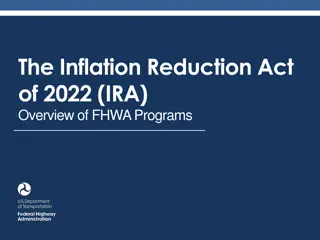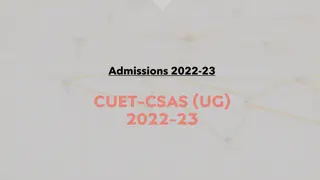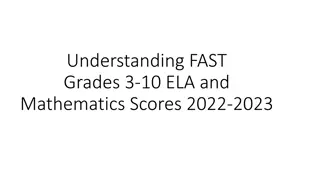
Understanding Gauss's Law in Dielectrics and Its Applications
Explore the principles of Gauss's law in dielectrics, analyzing charge distribution, electric displacement, and polarization vectors. Learn about the electric susceptibility and dielectric constant in isotropic media.
Download Presentation

Please find below an Image/Link to download the presentation.
The content on the website is provided AS IS for your information and personal use only. It may not be sold, licensed, or shared on other websites without obtaining consent from the author. If you encounter any issues during the download, it is possible that the publisher has removed the file from their server.
You are allowed to download the files provided on this website for personal or commercial use, subject to the condition that they are used lawfully. All files are the property of their respective owners.
The content on the website is provided AS IS for your information and personal use only. It may not be sold, licensed, or shared on other websites without obtaining consent from the author.
E N D
Presentation Transcript
4 3: Gauss's law in dielectrics In the following figure, the entire surface S is an imaginary closed surface located inside a dielectric medium. There is a certain amount of free charge, ?????, in the volume ? enclosed by S, and we shall assume that this free charge exists on the surface of three conductors in amounts q1, q2, and q3. By Gauss law; S . ? .? ?? =1 ?????+ ?? . . . (1) ? ? where: S: is the surface bounding the volume V. ?????: free charges inside conductors S1, S2,S3. ??: polarized charges inside the dielectric and onto its surface, such that: ??= ?.? ?? + ?. ? ?? ? ?1+?2+?3
. . ??= ?.? ?? + ?. ? ?? ? ?1+?2+?3 Appling the div. theorem in the volume integral term in last eq., yields; . . . ??= ?. ? ?? + ?. ? ?? = ?. ? ?? ?+?1+?2+?3 ?1+?2+?3 ? .? .? ?? =1 .?. ? ?? sub. in equation(1); ? ?????? ? .?. ? ?? =????? .??.? ?? + ? . ?? + ? .? ?? = ????? ? ? Integral form of Gauss's low in dielectric Inside the closed surface, the vector summation ?? + ? may be replaced by a vector ?, and the above equation can be re-writing as;
. ?.? ?? = ?????= ??? ? where ? is called the electric displacement vector also,?????= ???, and again applying the div. theorem, yields: ? ?.? = ? Differential form of Gauss's low in dielectric ??.??? = ? ?? ?? The total E at each point in the dielectric medium is expressed as the sum of two parts: ? ?,?,? =1 ?0 ? ?,?,? 1 ?0?(?,?,?)
For isotropic (homogeneous) dielectric media, the polarization vector ? and the electrostatic field ? have the same direction. For a linear medium,? is directly proportional to ? , thus we can write; ? ? and ? = ? ?= ????? where??is the electric susceptibility of the material, which is a dimensionless constant. But: ? = ? ? + ?? and ? = ? +????? = ? 1 + ???. . . (#) If ??= 0 ,i.e. the medium is a vacuum , and then : ? = ? ? (electric displacement for vacuum) otherwise: ? = ?? (electric displacement for medium) where, ? is the Permittivity is a measure of the ability of a dielectric material to be polarized by an electric field. Sub. last equation in left hand side of eqn.(#), yields; ? ? ? = ? 1 + ?? ? ? = ? 1 + ?? =?? ? = 1 + ?? or ? = ??=? ? = 1 + ?? Where K or?? is the dielectric constant (relative permittivity) of a medium (dimensionless quantity).
Solved problems: (Schaum ch.7) Q: Find the magnitudes of ? and ? for a dielectric material in which ? = 0.15 ???/?, and ??= 4.25 . Solution: We have: ? = ?? = ????? where: ??= ? ??. Sub. in eq. of ?, yields; ? = ????? ??= 1 + ?? = 5.24 ? = ????? = 6.96??/?2 ? = ?????= ?.????/??
4 4: Electrostatic field produced inside a polarized object, Lorentz field model ?? macroscopic . . ) ( .
In order to determine the electrostatic field at the center of a spherical cavity inside a polarized medium and due to the surface polarized charges on its surface, as in the following fig.;
From last discussion, the distribution of charges is only on sphere's surface. According to Coulomb's law, the electric field is given as; ?? 1 ??? ? = 3??? ?? . . . (1) 4??? ? 0 from equation(9) in section 4-2, we have: ??= ?. ? = ?cos ? ? = ?????, also in spherical coordinate ?? = ?2????????, substituting these in eq.(1), yields; 2? ? 1 ? 3(????)?2?????? ??? ? = ( ?????) ?? 4??? ? 0 0 the additional ???? term is added because we are evaluating the field that only is in the polarization direction. ? ???3? 3 ????2?( ????)?? 0 2??? ?= ? ? ? 1 3 1 +1 ?= ? ??? ? = 4??? 0 2?? 2?? 0 ? ? ??? ? = 3?? This is the macroscopically averaged E -field at the center of an imaginary small diameter sphere of radius ? (somewhere) deep inside of a uniformly polarized dielectric
4 5: Point charge in a dielectric fluid: Apply Gauss's law to a spherical surface of radius ? encloses some electric charge ? which is located inside a dielectric fluid, such that it behaves as a linear, isotropic medium. In this situation, ?, ? and ? are all parallel. For convenient, ? will be located at the origin. Then, application of Gauss's law, in scalar form; ? 4??2? = ? and ? = 4??2 4??3 ? , ? =? ? , ? =? ? In vector form: ? = ? ? we have = ??= ?/?? ? = ??, then; = ??= 1 + ? = 4? ???3 ? ? ?? ? = ??= ??? 1 ? ??? ? = ??? 1 , 4? ???3 ? Thus; ? =( 1)? 4? ?3 ?
. . p . ? = ?? ) (K) ( : q p= ?.P ( p= ?.P = 0) . : ?. 1 ? ? ?4??2?. ? ??= lim ?=?= ??= ?(1 1)






















